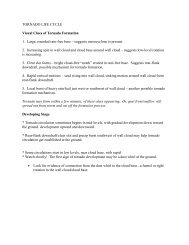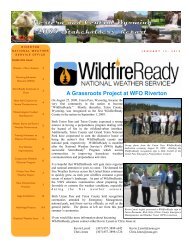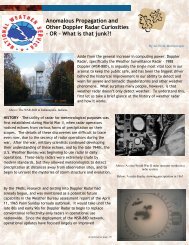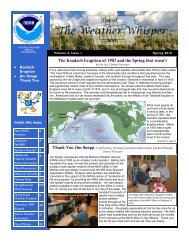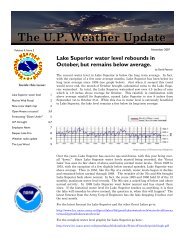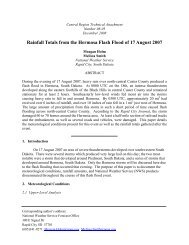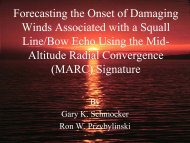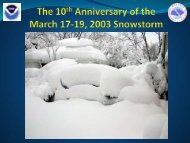Extended Abstract - AMS supported meetings
Extended Abstract - AMS supported meetings
Extended Abstract - AMS supported meetings
Create successful ePaper yourself
Turn your PDF publications into a flip-book with our unique Google optimized e-Paper software.
continues to push towards the south and west over<br />
the lower terrain of far southwest Colorado.<br />
After 23 UTC (5 pm MDT), the maximum lighting<br />
activity continues over Palmer Divide and Raton Mesa<br />
and extends eastward out onto the plains. Flash rates<br />
in excess of 1.0 flash km -2 are still noted over the<br />
plains. Flash rate values continue to decrease over<br />
the remainder of the state, especially over the interior<br />
mountain regions. The only noticeable maximum west<br />
of the Continental Divide is across far Southwest<br />
Colorado.<br />
After 00 UTC (6 pm MDT), flash rates continue to<br />
decrease statewide. The plains continues to show the<br />
maximum in activity. However, flash rates are now<br />
below 1.0 flash km -2 over this region.<br />
From 01 UTC (7 pm MDT) through the 11 UTC (6<br />
am MDT), lightning activity gradually decreases<br />
across the State. At 01 UTC, the highest flash rates<br />
are over the plains and adjacent mountains. A small<br />
secondary maximum is also noted over far Southwest<br />
Colorado. Over the remainder of the interior mountain<br />
areas, flash rates are typically below 0.3 flashes km -2 .<br />
By 04 UTC, flash rates in the mountains are generally<br />
below 0.1 flashes km -2 . Over the plains, flash rates<br />
continue to decrease with the highest values (0.3<br />
flashes km -2 ) noted over the far eastern plains.<br />
By 06 UTC (Midnight MDT), flash rates are<br />
generally below 0.1 flashes km -2 statewide. Many<br />
areas of the interior mountains show no lightning<br />
activity at all. Through the remainder of the early<br />
morning hours the activity continues to slowly<br />
decrease.<br />
5 DISCUSSION<br />
This study analyzed the CG activity over the<br />
State of Colorado over a 16 year period. The mean<br />
annual flash density map showed most of the CG<br />
activity occurs over the Pikes Peak/Palmer Divide<br />
region and across the east facing slopes of the<br />
Southern Sangre De Cristo mountain range/Raton<br />
Mesa region.<br />
Minimum in CG activity was found over the San<br />
Luis Valley. Somewhat surprisingly, a minimum in<br />
activity was noted north of Denver to Ft Collins and<br />
across the northern sections of the Front Range.<br />
Minimum in activity was also noted over one of the<br />
highest mountain ranges in Colorado, the Sawatch<br />
Range.<br />
Of interest, initial lightning “hotspots” were not<br />
found directly over the higher mountain peaks, but<br />
just to the east of the higher peaks.<br />
As found by Lo´pez and Holle (1986), lightning<br />
begins to increase over the higher terrain of Colorado<br />
around 17 UTC (11 am MDT).<br />
The overall minimum in activity occurs over the<br />
State during 14 UTC (8 am MDT), the maximum<br />
occurs around 22 UTC (4 pm MDT).<br />
The hourly plots show that the lightning activity<br />
which develop along the mountains adjacent to the<br />
plains moves east as the afternoon progresses. Over<br />
the San Juan mountain region, the activity moves in a<br />
general southwest direction during this same time<br />
period.<br />
6 ACKNOWLEDGMENTS<br />
The Authors would like thank Bill Fortune (MIC<br />
NWS Pueblo CO) for his support, and Irv Watson<br />
(SOO NWS Tallahassee FL). Precipitation data was<br />
supplied by the Prism Group, Copyright 2006, Oregon<br />
State University, http://www.prismclimate.org. The<br />
Prism data was downloaded 10 August 2006.<br />
7 REFERENCES<br />
Doesken, N. J., and R. A. Pielke, 2003: Climate of<br />
Colorado. Internet document:<br />
http://ccc.atmos.colostate.edu/climateofcolorado.php<br />
López, R. E., and R. L. Holle, 1986: Diurnal and<br />
spatial variability of lightning activity in northeastern<br />
Colorado and central Florida during the summer.<br />
Mon. Wea. Rev., 114, 1288–1312.<br />
Szoke, J., D. Barjenbruch and R. Glancy, 2006: The<br />
Denver Cyclone and tornadoes 25 years later: the<br />
continued challenge of predicting non-supercell<br />
tornadoes. <strong>AMS</strong> 26 Severe Local Storms Conf., St<br />
Louis, MO (this volume).<br />
Watson, A. I., R. L. Holle, and R. E. López, 1993:<br />
Cloud-to-ground lightning and upper-air patterns<br />
during bursts and breaks in the Southwest Monsoon.<br />
Mon. Wea. Rev., 122, 726–1739.




